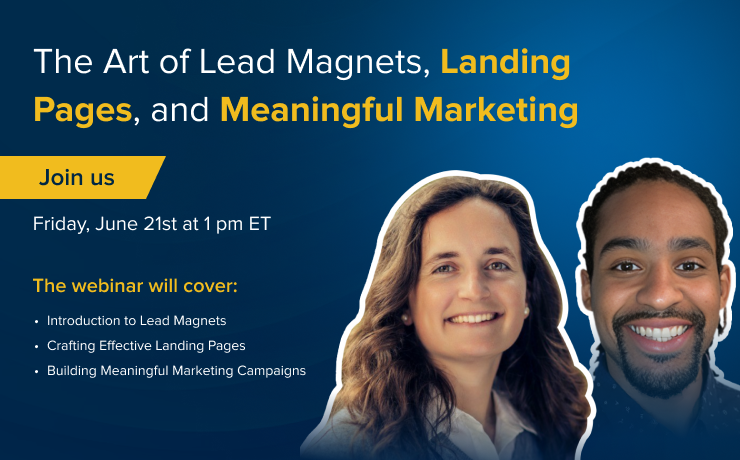The Art of Lead Magnets, Landing Pages, and Meaningful Marketing: Webinar Recap

Cassandra Goethe
Marketing Coordinator

Presented by HotJar and SmartSites, “The Art of Lead Magnets, Landing Pages, and Meaningful Marketing” discussed effective strategies for optimizing landing pages, utilizing lead magnets, and creating impactful marketing campaigns.
Jadeverett Mayhorn (from SmartSites) and Katherine Hutter (from HotJar) shared their expertise and practical advice. Here’s a recap of the key takeaways.
About the “The Art of Lead Magnets, Landing Pages, and Meaningful Marketing” Webinar
The webinar kicked off with a brief introduction from the speakers, who emphasized the importance of landing page optimization in paid search campaigns.
Given the substantial investment in driving traffic to these pages, understanding how to build and track their success is important.
The Importance of Lead Magnets and Landing Pages
Jadeverett emphasized that lead magnets are the backbone of effective digital marketing. They attract, capture, engage, and ultimately convert leads into customers.
“Leads with contact information are the lifeline of a business.”
The key is to offer specialized, valuable content that resonates with the audience’s goals. Additionally, it must be supported by optimized landing pages with clear calls to action.
Types of Lead Magnets:
- Ebooks
- Fact Sheets
- Case Studies
- Quizzes
- Toolkits
- Consult Calls
- Free Trials
Choosing the right lead magnet depends on the audience’s needs and preferences. Each type can effectively capture and nurture leads through the sales funnel.
Maximizing Sales Funnels
Jadeverett outlined a four-step process to maximize sales funnels:
- Discover: Pinpoint your audience’s needs and pain points.
- Engage: Create compelling solutions based on insights.
- Automate: Streamline the nurturing process with email automation.
- Convert: Drive targeted traffic and optimize sales funnels based on conversion metrics.
By implementing these steps, businesses can attract leads, nurture them effectively, and convert them into loyal customers.
Crafting the Perfect Landing Page
Creating a high-converting landing page requires careful attention to several key elements:
- Headlines: Start with a grabbing headline that resonates with the audience’s pain points.
- Captivating Story: Engage visitors with a story that highlights their problem and presents your product as the solution.
- Testimonials and Social Proof: Build trust with real experiences and results.
- Clear Call to Action: Ensure the desired action is crystal clear with prominent CTA buttons.
- Minimal Distractions: Keep the design clean and focused to maintain attention on the main call to action.
Building Meaningful Marketing Campaigns
Jadeverett stressed the importance of a customer-centric approach to marketing. Instead of merely promoting the company, the focus should shift to providing value that resonates with the audience’s needs and desires.
Sharing stories and educational resources empowers potential customers to make informed decisions.
Stages of the Customer Journey
- Inspire: Create an emotional connection by sharing your brand story, values, and mission.
- Convert: Use lead magnets, landing pages, and sales funnels to guide leads through the conversion process.
- Transform: Showcase testimonials and success stories to demonstrate the positive impact of your offerings.
Optimizing Landing Pages with Data
Katherine discussed the importance of understanding user behavior on landing pages to drive more opt-ins.
By collecting data through heat maps, session recordings, and surveys, businesses can gain insights into what works and what doesn’t.
“Take the time to observe and understand your users. You can increase the quality of your landing pages by updating their designs and content.”
Key Data Collection Methods
- Heat Maps: Overview of user activity on a page.
- Session Recordings: Track mouse movements to identify frustration points.
- Surveys: Gather direct feedback from visitors.
Continuous Testing and Improvement
The process of optimizing landing pages is continuous. Katherine outlined a cycle of collecting data, developing hypotheses, testing ideas, and analyzing results.
By repeating this process, businesses can keep improving their landing pages and stay ahead of changing trends and consumer preferences.
Case Studies and Success Stories
The webinar highlighted several case studies to illustrate the power of effective lead magnets and landing pages:
- SmartSites: Utilized strategic lead magnets like pre-proposals and account audits to generate qualified leads.
- Headspace: Offered free trials through landing pages, leading to increased user engagement.
- Square Payment Processing: Used webinars and guides to attract and convert prospects.
Key Takeaways
- Convert with Confidence: Use lead magnets and landing pages to boost conversion rates.
- Elevate Your Brand: Build meaningful connections with personalized marketing campaigns.
- Impactful Integration: Seamlessly integrate lead magnets and landing pages into your strategies.
- Transform Your Revenue: Experience significant revenue growth with high-converting landing pages.
- Learn from Success: Apply strategies from successful companies like SmartSites, Headspace, and Square.
Changing one’s focus on creating compelling lead magnets, optimizing landing pages, and building meaningful marketing campaigns can help drive engagement, nurture leads, and achieve greater success.
For those interested in the full webinar, feel free to visit this link: https://www.youtube.com/watch?v=R7nu8kshZ0A.
-
 Free
Consultation
Free
Consultation
-
 Free
Google Ads Audit
Free
Google Ads Audit







